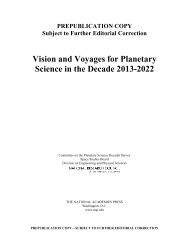Planetary Geology pdf - Solar System Exploration
Planetary Geology pdf - Solar System Exploration
Planetary Geology pdf - Solar System Exploration
You also want an ePaper? Increase the reach of your titles
YUMPU automatically turns print PDFs into web optimized ePapers that Google loves.
Exercise<br />
Two<br />
Volcanism<br />
Purpose<br />
By studying aerial photographs you will learn to<br />
identify different kinds of geologic features, tell<br />
how they differ from one another, and learn the<br />
processes involved in their formation.<br />
Ruler (metric)<br />
Materials<br />
Introduction<br />
The four major geologic processes (gradation,<br />
impact cratering, tectonism, and volcanism) each<br />
produce distinct landforms. A landform can be<br />
Questions<br />
1. Examine the cinder cone of Mount Capulin, New Mexico, shown in Figure 2.1. The depression at its summit<br />
is referred to as a volcanic crater.<br />
a. Describe the general shape of the cone and the volcanic crater at the top.<br />
b. What is the white spiral line from the base of the cone to the crater rim?<br />
Based on the elevation of Mt. Capulin (334m) and the information provided by the aerial photo, the slope<br />
of the volcano's sides can be calculated. This simple sketch of Mt. Capulin will help.<br />
Exercise Two: Geologic Landforms<br />
Seen on Aerial Photos<br />
Name<br />
Geologic Landforms<br />
Seen on Aerial Photos<br />
EG-1998-03-109-HQ Activities in <strong>Planetary</strong> <strong>Geology</strong> for the Physical and Earth Sciences<br />
17<br />
identified based on its shape and form, or its<br />
morphology. Volcanism is the eruption of melted<br />
rock (called magma) and its associated gases onto<br />
the surface of the Earth. Volcanism commonly produces<br />
volcanoes and volcanic flows. Tectonism<br />
involves the movement of rock by fracturing and<br />
faulting, which results in earthquakes. Gradation<br />
involves the erosion, transportation, and deposition<br />
of surface materials. On Earth, running water, wind,<br />
gravity and ice are the major agents of gradation.<br />
Impact cratering occurs when material from outside<br />
the EarthÕs atmosphere (such as meteoroids and<br />
comets) strike the surface. The aerial photographs in<br />
this exercise will help you recognize landforms and<br />
the geological processes that formed them. These<br />
processes act on other planets, where they can generate<br />
similar landforms.<br />
x<br />
y











